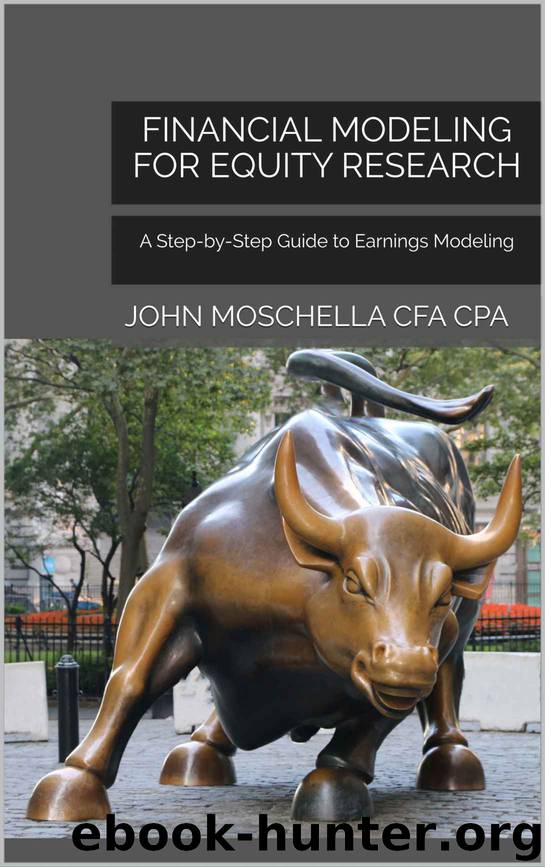Financial Modeling For Equity Research: A Step-by-Step Guide to Earnings Modeling by John Moschella CFA CPA

Author:John Moschella CFA CPA [Moschella CFA CPA, John]
Language: eng
Format: azw3
Published: 2017-09-28T04:00:00+00:00
Step 14: Primary Financial Statement Links
After the Income Statement, Balance Sheet, and Cash Flow Statement are complete, take a minute to review how the three statements are interrelated. The following is a recap of the primary links. The cell references correspond to the Tier 1 Excel model template included with this book (visit www.GutenbergResearch.com/book to download) or refer to the Tier 1 model in Exhibit 6 from Chapter 1.
Retained Earnings: GAAP net income (Income Statement, cell AP27 from Exhibit 6 in Chapter 1) flows through retained earnings (Balance Sheet, cell AP173, Exhibit 6). Dividends (Cash Flow Statement, cell AP231, Exhibit 6) are also paid out of retained earnings (Balance Sheet, cell AP173, Exhibit 6), and if the company does not disclose treasury shares separately in the equity section, we subtract share repurchases (Cash Flow Statement, AP232, Exhibit 6) from this account. The calculation starts with the beginning retained earnings balance of $100.925B (cell AO173, Exhibit 6), plus net income of $8.142B (cell AP27, Exhibit 6), minus dividends of $3.208B (cell AP231, Exhibit 6), minus share repurchases of $5.000B (cell AP232, Exhibit 6), equals the ending retained earnings balance of $100.859B (cell AP173, Exhibit 6).
Income Statement Links to the Cash Flow Statement: GAAP net income (Income Statement, cell AP27, Exhibit 6) is the starting point for the Cash Flow Statement (cell AP201, Exhibit 6). Since the starting point for the Cash Flow Statement is the ending point of the Income Statement, all of the assumptions made to the future earnings forecast will impact the projected cash flows.
Balance Sheet Links to the Cash Flow Statement: All of the changes in the Balance Sheet accounts are reflected throughout the Cash Flow Statement. For example, in the projected fiscal third quarter, inventory (Balance Sheet, cell AP147, Exhibit 6) decreased from $2.910B to $1.996B. The decrease in the asset balance represents a cash inflow of $0.914B, and is reflected in the Cash Flow Statement (cell AP211, Exhibit 6).
Cash Flow Links to the Balance Sheet: The Cash Flow Statement will add all the inflows and outflows of cash (cell AP237, Exhibit 6) to the beginning cash balance (cell AO239, Exhibit 6), to arrive at the ending cash balance (cell AP239, Exhibit 6) which flows to the Balance Sheet (cell AP144, Exhibit 6). This is the final link which ensures that the assets reported on the Balance Sheet equal the liabilities plus equity.
Download
This site does not store any files on its server. We only index and link to content provided by other sites. Please contact the content providers to delete copyright contents if any and email us, we'll remove relevant links or contents immediately.
Rich Dad Poor Dad by Robert T. Kiyosaki(6174)
Pioneering Portfolio Management by David F. Swensen(6078)
How To Win Friends and Influence People by Dale Carnegie(4332)
The Money Culture by Michael Lewis(3846)
The Dhandho Investor by Mohnish Pabrai(3560)
The Wisdom of Finance by Mihir Desai(3523)
Liar's Poker by Michael Lewis(3220)
The Intelligent Investor by Benjamin Graham Jason Zweig(2930)
The ONE Thing by Gary Keller(2918)
Mastering Bitcoin: Programming the Open Blockchain by Andreas M. Antonopoulos(2891)
Fooled by Randomness: The Hidden Role of Chance in Life and in the Markets by Nassim Nicholas Taleb(2860)
Rich Dad Poor Dad: What The Rich Teach Their Kids About Money - That The Poor And Middle Class Do Not! by Robert T. Kiyosaki(2834)
Investing For Dummies by Eric Tyson(2793)
How to Win Friends and Influence People by Dale Carnegie(2793)
How to Day Trade for a Living: Tools, Tactics, Money Management, Discipline and Trading Psychology by Andrew Aziz(2785)
Market Wizards by Jack D. Schwager(2538)
Zero Hour by Harry S. Dent Jr. & Andrew Pancholi(2532)
How to Pay Zero Taxes, 2018 by Jeff A. Schnepper(2498)
Rich Dad's Guide to Investing by Robert T. Kiyosaki(2410)
